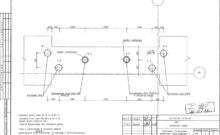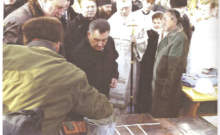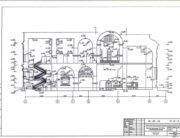According to the research conducted, such a periodization of the construction of the Assumption Cathedral was adopted: And the period (1073-1109 years), II period (1109 – second half of the XII century), III period (XIII-XV century), IV period (XVI century – 30 – s of the XVII century), V period (1638-1677 years), VI period (90s of the XVII century – 1718), VII period (1718-1780 years). Within each period, several stages were identified and the nature and characteristics of each of them were formulated. In the first period of construction, there are three stages: 1073-1087, 1088-1089, 1090s. – 1109 at the first stage of laying the original volume of the cathedral was made of brick-plinfs, the dimensions of which according to M. Kholostenko are 37x28x3.5 (4) cm, 35x29x3.5 (4) cm, 35 x 27 x 4 cm, using the opus mixtum technique “And with recessed near the use of a significant number of boulders. The first stage in the remains of the Assumption Cathedral is represented by laying on lime-cement mortar type I according to the table of mortars. This solution consists of the northern apse, the central apse, the northern part of the southern apse, the domed columns, and the lower part of the southern wall of the cathedral at the place of its connection to the original porch.
At the second stage, the composition of mortar baptismal was almost similar to the solutions of the main volume of the temple, as well as the smalt and character of the calculations of the shaped parts of the cathedral and the baptismal. The dimensions of the plinfs at the third stage of the first period of the construction of the cathedral somewhat differ from the dimensions at the previous stages – they are smaller and amount to 30x20x4.5 cm, 32x21x4 (4.5) cm, 33x22x4.5 cm, 33x24x4.5 (5) cm.
At the fourth stage, in the second period, the overall architectural appearance of the Assumption Cathedral remained unchanged, as of October 1998, construction materials of this stage were not found, just as no technological features and building materials for them of the fifth stage were found: ZiO is considered the works of the fifth stage had only a repair character. Fragments of the foundation adjacent to the southern outer wall of the pavilian volume of the cathedral from the south to the southern outer wall can be hypothetically attributed to the sixth period – along the axis of the inner wall between the vestibule and the cloak. In the collapse of the southern wall, at the level of its base, reddish-colored masonry on type III mortar was also found above the basement masonry on type I.
At the seventh stage, in the third period, large-scale eobot repair was carried out, which consisted of rebuilt vaults, parts of the south-eastern dome column, arches and a drum of the central dome, as well as domestic structure of the destroyed southern wall and southern part of the southern apse. The masonry was repaired with bricks of various sizes. Renovation of the cathedral at the eighth stage (1235-1470). It consisted in transferring the vaults, the drum of the dome and in the housework of the ruined southern wall and the southern part of the southern apse.
The masonry of the ruined southern wall of the cathedral was made of brick – plinfs of the XI century. the reuse with which the upper part of the southern wall was composed, the southeastern dome column, the arches adjacent to it, and the drum of the central dome. The southern wall was made in the technique of rubble masonry: the middle layer of the masonry consisted of broken brick of the 11th century, Stones, pieces of cement mortar, fragments of slate slabs, and the veneer was made using a technique of roving on a white solution with undercutting seams. Basically, the re-use of the plinth was not cleared from the original solution, it firmly stuck to it. Mortar type V at this stage is characterized by a different composition from the previous ones – with a lime binding and sandy aggregate. A mortar from a destroyed building of the 11th century was mixed with the solution. This solution was found within the southern wall on the south side and on the interior side. Along with the use of brick-plinfs from the destroyed parts of the cathedral, there was a change of building material – a grooved brick appeared, the dimensions of which were 25x12x8.5 (9) cm, 25x16x9 (9.5) cm, 30x15x9.3 (9.5) cm. Repair The upper part of the southern wall was made of bright red brick and the same brick was laid by nishiarks on the southern facade.
The fourth period in the history of the construction of the Assumption Cathedral consisted of two stages. At the ninth stage was built of brick size 27x14x6.5 cm and 28x13x6.5 cm John-Theological chapel. At the tenth stage, between 1577 and 1625, the Stefanivsky limit was added to the cathedral from the north side. Around this time, the Eltsev Chapel was completed to the east wall. In the existing remains of the cathedral, traces of the tenth building phase are insignificant. On the southern facade, at the junction of the eastern wall of the Stefanivsky chapel to the facade of the cathedral, remains of the masonry chapel are preserved. This place is extremely interesting due to the fact that there are three multi-temporal construction stages joined with the corresponding solutions – the first stage of the end of the XI century, the sixth stage of the second half of the XII century, and the tenth stage of the first half of the XVII century.
The fifth period in the history of construction also consists of two stages. The works of the eleventh construction stage consisted in the restructuring of the John-Theological and Stefanivsky chapels: both side-chapels received faceted apses from the outside, above which were raised six-sided drums decorated with domes. In front of the southern façade, the Three Saints limit was built. The masonry mortar of this stage belongs to type VI, the remnants of the masonry of this stage are represented in the apse parts of John-Theological and Stefanivsky Chapels. No data on technological features and building materials in the next twelfth stage has been preserved.
In the sixth period, only one construction stage was highlighted. As of October 1998, this stage was not found in the existing remains of the cathedral, its technological features have not been investigated. The last seventh period of the construction of the Assumption Cathedral consists of two stages. At this stage, masonry mortar VIII was used, the remnants of this stage represent fragments of the masonry of the John theological chapel (south wall to the height of two tiers) and Stephanie chapel (basement of the northern wall). In the last stage, the outer parts of the apses were composed of type IX solution.



















